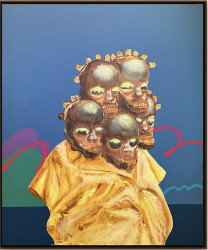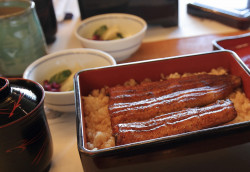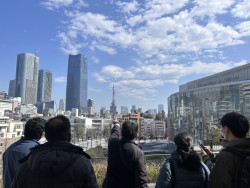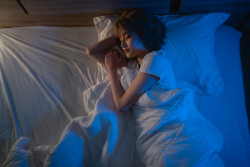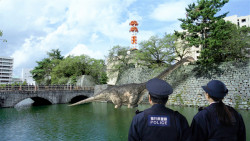
Originally published on metropolis.co.jp on September 2012


See here for a feature on what to do in Yokosuka.
For all its “International City of Culture by the Sea” aspirations, Yokosuka City Council has sought to promote the kaigun (navy) curry and the Yokosuka burger above the fresh-from-the-sea goodness that is a given at a port town such as this. And if Japanese-style curry is your thing, you’ll be spoilt for choice. The city is supposedly where British sailors first brought curry to the masses in the Meiji era. Your first stop should be YY Port, aka kaigun curry central. Find it straight ahead out the east exit of Yokosuka-chuo station and on the right. Here you’ll receive a map of the top vendors citywide, and take-home curry shopping options to make your head spin. The staff are knowledgeable and friendly, albeit in Japanese only.

To bypass the curry wisdom of YY Port, you could head directly for Gyorantei Curry Kan (www.gyorantei.com) just north of Dobuita street. Their speciality is navy curry from the late nineteenth century. The interior is accordingly maritime themed, with a cavernous brick interior, ropes and wooden barrels, and a curious choice of Italian operetta BGM, at least when we visited. They offer menus in English and are open all week. Prices start at ¥900 for a plate of—you guessed it—curry and rice.
On every Keihin Kyuko line train heading towards Yokosuka you will see posters advertising glistening meat-filled buns overflowing with cheese, pickles and sauce. And unlike at certain burger chains, the Yokosuka Navy Burger is everything in the flesh that it claims to be on paper. Catering to American tastes and appetites, this meat behemoth is available at a selection of restaurants on Dobuita Street. You’ll be spoilt for choice, but if you really can’t make up your mind, Honey Bee’s claims to be the first and original Navy Burger restaurant in Japan. The fare’s fare is usually around ¥1,000 and it’s the standard uniform’s way to line the stomach before a night on the tiles in the same street.
One gem Metropolis stumbled upon during a recent visit was Nawlins (2-9 Odagawacho. Tel: 046-821-0321), where catfish po’ boy sandwiches (from ¥800) are the specialty, along with gumbo (¥1,000), shrimp étoufée (¥1,300) and their savoury, filling and spiced-with-a-soupçon-of-paprika red beans ’n’ rice (¥750)—try finding that elsewhere in Japan.

Yokosuka has its fair selection of izakaya, and ranking up among the top is Banzai Honten (www.banzai-inc.com) for its encyclopaedic selection of drinks and good-value, varied eats. This is the flagship venue of the successful local Banzai chain. The interior is a stylishly converted storehouse and the efficient staff are also friendly. Expect to pay from ¥3,000 per head for an evening’s food and libations. There is an English menu and even a nonsmoking room.
A short walk away is the newly-refurbished Tiger Yakiniku. Having lost nothing of its charm or excellent service in transit, the cook-it-yourself charcoal grilled-meat restaurant is now on the fourth floor of the Miura building. This is the port of call for serious beef eaters, and features the legendary Matsuza marbled beef. Also on the menu is a succulent local fish option, and a spicy poached egg in miso soup. Wash it down with house specialty the Tiger sour, made with shochu, ginger ale and lime. Expect to pay about from ¥2,500 to ¥3,500 per head and up for a blow-out. Reservations advised, English menu available.
On the other side of the station from Dobuita are the lanes known collectively as Yonegahama. At worst, this is a cockroach-infested sleaze-hole, where the doors of the snaku bars openly proclaim their refusal to admit non-Japanese. But in and amongst the dross lie the pearls that make an excursion to Yonegahama more than worthwhile.
For a good fill-up from a varied menu, try Pink Pony Café. The emphasis here is on fresh, local and international produce. There is no English menu, but the staff can help you negotiate the linguistic minefield. This is one of the more family-friendly city centers, and there is ample coin parking nearby. Expect to pay about ¥3,000 per head to gorge copiously. Recommended are the home-made pizzas, pasta dishes and dragon rolls.
The Yokosuka Blue Note is on hand to follow your dining experience with some modal strains. Resurrected from the ashes of the Mikasa Dori venue, the lady of the house mixes a mean cocktail, stocks an enviable selection of whiskies and takes you back to the days of early Cassavetes movies with her strictly-vinyl jazz sounds in this miniscule yet stylish venue. Prices are ¥500 for a coffee, about ¥900 per cocktail. Smoking is permitted, and there is no food on the menu.

Whereas Yonegahama only really wakes up when the sun goes down, there are plenty of places throughout the city for a quick lunch-time refuel; try Sio Café (Tel: 090-2734-3332. http://sio-cafe.com) on Route 16 for a plate of whatever excellent fresh, seasonal and local produce the chef is cooking that day. Expect stews, Thai-style curries, salads and rice sides. This tiny, modern cafe is also famous for its New York style cheesecake and carrot cake, and serves the local brew, Shonan Beer.
Meanwhile, on the other side of town, en route back from a day at Kannonzaki (see feature, p.8-9) is the year-round beach café Kaneyo Shokudo. This is a perfect place to relax on the beach with a refreshing and well-mixed cocktail, and watch the sun go down over Tokyo Bay and gaze toward Mt. Fuji. The menu is comprehensive and eclectic, with excellent desserts. Locals fill up this place year round, which tells you something. Pay about ¥3,000 for a meal with drinks. To get there, take the number 24 or 28 bus from in front of Yokosuka-chuo station (the adult fare is ¥360, approx. 35 mins) and alight at the Bijutsukan Mae stop.
The Yokosuka Acquamare restaurant, part of the Acqua Pazza chain, is the restaurant in front of the Yokosuka Museum of Art and as such its entire length is glazed glass, giving all diners a spectacular view of sea, sky and the shoreline across Tokyo Bay. With an unfussy décor—and outside tables, too—this delightful restaurant offers reasonable lunch menus starting from ¥1,350, dinner menus from ¥4,500, à la carte options and an extensive wine list, and is worth the trip alone. The emphasis is on seafood and European flavors. The changing seasonal menus might include risotto, seafood pasta or herb chicken, and the service is friendly and efficient—although there is no English menu. The vegetarian option when we visited was keema curry with a properly poached egg nestling on top.
See here for a feature on what to do in Yokosuka.
